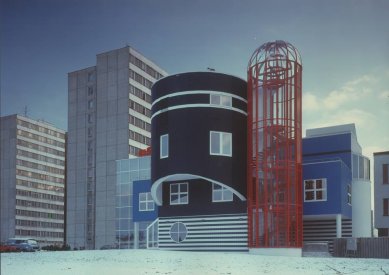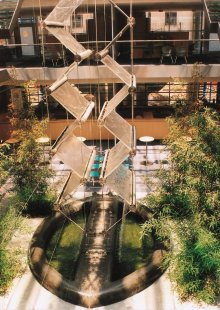
Temples of Money: The Architecture of Banks and Savings Banks in the 1990s.
We warmly invite you to the screening of the documentary by Jana Pavlová (Theory and History of Art at VŠUP) and Martin Hrubý (Studio of Intermedial Confrontation at VŠUP) followed by a discussion with architects at the new cultural space in Brno.
The screening will be accompanied by a discussion with architects Michal Gabriel, Karel Tuz, and other guests.
The event will take place on Tuesday, 11/11 at 7 PM at the new cultural space PRAHA/Fórum for architecture and media, Husova 18, Brno (entrance from the courtyard of the Pražák Palace MG).
The documentary "Temples of Money" presents the architecture of banking houses and savings banks in the 1990s as a phenomenon associated with the socio-political change after 1989. Similar to other former socialist states in Europe, the Czech architectural scene found itself at a crossroads of various stylistic opinions and movements after the revolution. Banking houses and savings banks became the most frequently constructed typology, best demonstrating the individual tendencies that emerged in Czech architecture at the beginning of the 1990s. The documentary aims to highlight that the opinions surrounding the acceptance and rejection of these buildings represent broader aspects in constituting the Czech architectural scene and, consequently, society after 1989. Banking houses created a representative model that matched the ideals of the newly forming economic sphere in a post-communist country. The emerging political system sparked a debate about the nature of architecture that would correspond to the character of a newly formed democratic republic. Many architects adopted various positions towards the new possibilities of creation, often linking aesthetic values with ethical ones.
A common feature of newly formed banking institutions is that the wave of waning postmodernism stamped its mark on their architectural form. The postmodern language, as a style that emerged at the intersection of two political regimes, proves to be a fundamental yet unclear issue when interpreting and reflecting on these buildings. The postmodern approach never fully established itself in the Czech environment. After the revolution, it was completely rejected by many architects as an empty fashion wave of uncritically adopted forms from the West. Postmodernism represented, in the Czech context, an unclear field of architectural thought. Around the architecture of banking institutions, a critical discussion erupted during the time of their realization, primarily addressing issues related to the financial costs and ostentatious form of these buildings. The buildings of banks and savings banks became symbolically representative of architectural failure and ethical failure often referred to as low or degraded postmodernism. Thus, the postmodern language became directly linked to the malpractices of capitalism in the early 1990s.
The documentary seeks to retrospectively approach and re-evaluate individual authorial concepts based on personal testimonies from bank architects - Michal Gabriel, Vladimír Štulc, and Jaromír Kročák. This provides a retrospective reflection on the complicated yet key period of architecture, mainly in the early 1990s, which is generally overshadowed because it represents, for many bank authors, an ever-living taboo concerning the use of postmodern style.
Many banking houses emerged as one large authorial work thanks to the leniency of investors. Architects were involved in designing the building itself, as well as in interior furnishings and the selection or own design of artworks found inside or in the immediate vicinity of the bank. One factor in the legacy of the previous regime was the tendency to collaborate on commissions with several prominent artists - for example, Jiří Sopko, Václav Cigler, Vratislav Novák, or Ivo Rozsypal.
This reflection comes at a time when banking institutions are moving away from the representative model of the 1990s and transitioning to overall standardization, particularly of interior elements. Many original authorial objects are disappearing without being documented. We are irretrievably losing a unique testament to banking architecture predominantly from the early 1990s, which has become, whether willingly or not, an intersection of architecture and society after 1989. Given the long-term negative view of both the banking institution and postmodernism itself as a qualitatively ambiguous period in Czech architecture, nearly a quarter-century later, it is time for a more sensitive re-evaluation.
The documentary will be followed by a discussion with invited guests: architect of the ČNB in Ústí, Michal Gabriel, and architects of banking institutions realized in Brno - Karel Tuz, the author of the former Agrobank on Česká Street, and others. The Brno architectural scene of the 1990s most prominently exhibits the tendency to return to the values of Czech functionalism, a style referencing the strong architectural tradition here. Functionalism most closely aligned itself with the ideals of the newly forming democratic republic. It represented a style meant to stabilize the architectural scene in the post-revolutionary euphoria and to divert it from unconsidered interventions caused by the atmosphere of post-revolutionary euphoria, often represented by the language of postmodernism. The discussion will address broader questions concerning to what extent discussions about the acceptance or rejection of postmodernism evoke any characteristic feature of Czech architecture, which struggles to reconcile the acceptance of concepts that shift considerations of architecture from purely practical and ethical points of view. Is it even possible to reassess the architecture of banking houses and savings banks in the 1990s from the perspective of a "Czech" architect? Does the acceptance of this architecture establish a more relaxed approach that could introduce tendencies in designing such as hybridity or pop-architecture into the Czech context?
PRAHA/Fórum for architecture and media is a new cultural space with a café located at Husova 18 in Brno (entrance from the courtyard of the Pražák Palace).
A public space growing from the inside out, a place for gathering and communication, connecting with the city and its communities, subcultures, institutions, and engaged citizens. Openness, barrier-free access, free movement, and freedom of expression as a principle.
Since October 2014, it has been operated by 4AM, z.s. in collaboration with the Moravian Gallery and other partners.
More information >
The screening will be accompanied by a discussion with architects Michal Gabriel, Karel Tuz, and other guests.
The event will take place on Tuesday, 11/11 at 7 PM at the new cultural space PRAHA/Fórum for architecture and media, Husova 18, Brno (entrance from the courtyard of the Pražák Palace MG).
The documentary "Temples of Money" presents the architecture of banking houses and savings banks in the 1990s as a phenomenon associated with the socio-political change after 1989. Similar to other former socialist states in Europe, the Czech architectural scene found itself at a crossroads of various stylistic opinions and movements after the revolution. Banking houses and savings banks became the most frequently constructed typology, best demonstrating the individual tendencies that emerged in Czech architecture at the beginning of the 1990s. The documentary aims to highlight that the opinions surrounding the acceptance and rejection of these buildings represent broader aspects in constituting the Czech architectural scene and, consequently, society after 1989. Banking houses created a representative model that matched the ideals of the newly forming economic sphere in a post-communist country. The emerging political system sparked a debate about the nature of architecture that would correspond to the character of a newly formed democratic republic. Many architects adopted various positions towards the new possibilities of creation, often linking aesthetic values with ethical ones.
A common feature of newly formed banking institutions is that the wave of waning postmodernism stamped its mark on their architectural form. The postmodern language, as a style that emerged at the intersection of two political regimes, proves to be a fundamental yet unclear issue when interpreting and reflecting on these buildings. The postmodern approach never fully established itself in the Czech environment. After the revolution, it was completely rejected by many architects as an empty fashion wave of uncritically adopted forms from the West. Postmodernism represented, in the Czech context, an unclear field of architectural thought. Around the architecture of banking institutions, a critical discussion erupted during the time of their realization, primarily addressing issues related to the financial costs and ostentatious form of these buildings. The buildings of banks and savings banks became symbolically representative of architectural failure and ethical failure often referred to as low or degraded postmodernism. Thus, the postmodern language became directly linked to the malpractices of capitalism in the early 1990s.
The documentary seeks to retrospectively approach and re-evaluate individual authorial concepts based on personal testimonies from bank architects - Michal Gabriel, Vladimír Štulc, and Jaromír Kročák. This provides a retrospective reflection on the complicated yet key period of architecture, mainly in the early 1990s, which is generally overshadowed because it represents, for many bank authors, an ever-living taboo concerning the use of postmodern style.
Many banking houses emerged as one large authorial work thanks to the leniency of investors. Architects were involved in designing the building itself, as well as in interior furnishings and the selection or own design of artworks found inside or in the immediate vicinity of the bank. One factor in the legacy of the previous regime was the tendency to collaborate on commissions with several prominent artists - for example, Jiří Sopko, Václav Cigler, Vratislav Novák, or Ivo Rozsypal.
This reflection comes at a time when banking institutions are moving away from the representative model of the 1990s and transitioning to overall standardization, particularly of interior elements. Many original authorial objects are disappearing without being documented. We are irretrievably losing a unique testament to banking architecture predominantly from the early 1990s, which has become, whether willingly or not, an intersection of architecture and society after 1989. Given the long-term negative view of both the banking institution and postmodernism itself as a qualitatively ambiguous period in Czech architecture, nearly a quarter-century later, it is time for a more sensitive re-evaluation.
The documentary will be followed by a discussion with invited guests: architect of the ČNB in Ústí, Michal Gabriel, and architects of banking institutions realized in Brno - Karel Tuz, the author of the former Agrobank on Česká Street, and others. The Brno architectural scene of the 1990s most prominently exhibits the tendency to return to the values of Czech functionalism, a style referencing the strong architectural tradition here. Functionalism most closely aligned itself with the ideals of the newly forming democratic republic. It represented a style meant to stabilize the architectural scene in the post-revolutionary euphoria and to divert it from unconsidered interventions caused by the atmosphere of post-revolutionary euphoria, often represented by the language of postmodernism. The discussion will address broader questions concerning to what extent discussions about the acceptance or rejection of postmodernism evoke any characteristic feature of Czech architecture, which struggles to reconcile the acceptance of concepts that shift considerations of architecture from purely practical and ethical points of view. Is it even possible to reassess the architecture of banking houses and savings banks in the 1990s from the perspective of a "Czech" architect? Does the acceptance of this architecture establish a more relaxed approach that could introduce tendencies in designing such as hybridity or pop-architecture into the Czech context?
PRAHA/Fórum for architecture and media is a new cultural space with a café located at Husova 18 in Brno (entrance from the courtyard of the Pražák Palace).
A public space growing from the inside out, a place for gathering and communication, connecting with the city and its communities, subcultures, institutions, and engaged citizens. Openness, barrier-free access, free movement, and freedom of expression as a principle.
Since October 2014, it has been operated by 4AM, z.s. in collaboration with the Moravian Gallery and other partners.
More information >
The English translation is powered by AI tool. Switch to Czech to view the original text source.



0 comments
add comment









